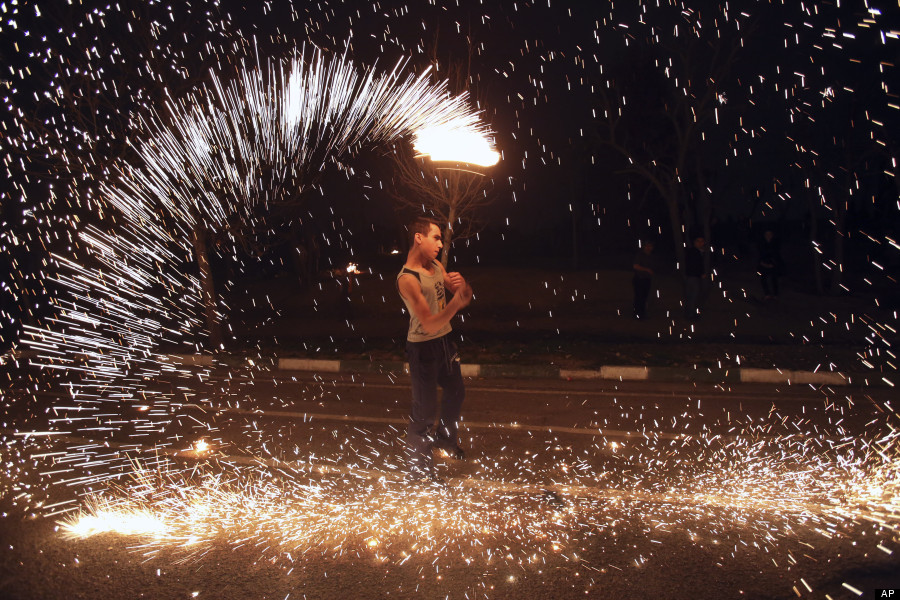For most people the view below would be a dizzying, terrifying spectacle. But for 25-year-old Tsang, it brings a sense of calm.
"The population is really dense and sometimes it's just kind of suffocating to the point where you need some time to yourself," he said. "That's mostly why I come up here."
Tsang, who asked AFP to use a pseudonym, is one of a growing number of so-called "urban explorers", a subculture of adrenaline junkies, photographers and history enthusiasts who treat the world's forgotten -- and often forbidden -- places as their own personal playgrounds.
The pursuit has long been popular in North America and Europe, and now Asia is becoming an increasingly sought after destination for an intrepid new generation of "urbexer".
In February two Russian daredevils scaled China's tallest building with their bare hands. Vadim Makhorov and Vitaliy Raskalov took advantage of lax security over the Chinese New Year holiday to sneak into the under-construction Shanghai Tower, releasing a hair-raising video of their stunt that went viral.
Hong Kong, a city with more skyscrapers than anywhere else in the world, is a particularly attractive destination for both local and international "rooftoppers", a daring subset of adventurers with a head for heights willing to risk arrest, injury and even death as they scale some of the world's tallest buildings.
- 'Wait for the right time' -
Getting to the top of many Hong Kong residential buildings, said Tsang, is often as easy as bluffing your way past the concierge and taking a lift to the top floor. But some of the tallest luxury complexes, hotels and office towers present a much greater challenge.
"You try and do as much research as you can. If other explorers have been there then you can get advice about how to get in -- like whether there is a hole in a fence somewhere," he said.
"Usually there are security guards but you just have to be patient. You can't just barge into a place and walk up to the roof. You have to wait for the right time."
Story Continues After The Gallery
Many attempts end in failure.
"The success rate on rooftops is probably 20-30 percent," he said. "And at times it can be discouraging. You might walk up 30-40 stories and then you discover you can't get past the final door. But when you do finally get to the top, wow, it's hard to describe. It's just beautiful."
Accessing the roof of the skyscraper - a luxury hotel in the city's bustling Kowloon district -- was alarmingly easy.
Tsang and an urbexing friend who uses her exploring name "Airin T" simply walked through a mall, into the hotel and took an elevator most of the way up. To avoid any guards or staff near the more exclusive penthouse suites, the last few storeys were made on foot via a staircase and through an unlocked door that led to the roof.
But any misconception that rooftopping is a safe hobby was soon dispelled as Tsang and his friend climbed a large illuminated dome at the top of the building. The ladder up to the dome hung over the edge of the skyscraper whilst the pathway at the top was little more than a foot wide. A slip on either would mean certain death.
"I do have a fear of heights," said Tsang, visibly elated from his climb. "It sounds kind of cliched but it's about facing your fears. And it really does help."
Hong Kong's police declined an interview request by AFP but warned that practitioners could face criminal damage and burglary charges in the event of any destruction of property. No explorers have been prosecuted to date.
- Windows into the past -
Yet not all forms of urban exploration are about seeking the adrenaline rush that comes from soaring above the crowds on towering rooftops.
Airin, a 25-year-old office worker by day, is a keen rooftopper. But she also spends much of her time exploring Hong Kong's myriad of abandonments, from shuttered mental asylums to discarded factories and crumbling apartment blocks.
Sporting bright blue hair, suspenders and a leather skirt, she looks like a character from a Manga comic as she strolls along the decaying paths around an abandoned village in Hong Kong's rural Sai Kung district.
In one house, she cuts past a traditional table still displaying ancestor offerings, up a rotten wooden staircase to a bedroom littered with broken pieces of furniture.
For Airin, who has gone urbexing as far afield as Russia, South Korea and Japan, abandonments offer a hidden window into the past.
"You can feel that time stops here and that's what attracts me," she says.
Wong Chuk Yeung is one of around 100 traditional villages in Hong Kong which lie shuttered.
"The young people move out and they have their families in the city. The old people stay and (eventually) die so it becomes abandoned," Airin said of the village.
Tsang believes urbexers are too often portrayed as adrenaline junkies and that their respect for leaving places untouched is ignored.
"There's a lot of people putting labels on us. Calling us thrill seekers, daredevils. That's true, there are some people like that but it doesn't fully represent this subculture," he says.
Meanwhile Airin believes more and more people across Asia will inevitably be drawn to explore the forbidden as the subculture grows.
"Everyone is actually born an explorer," she concludes. "But they just don't realise it."








 stay
stay ski
ski  see
see après
après